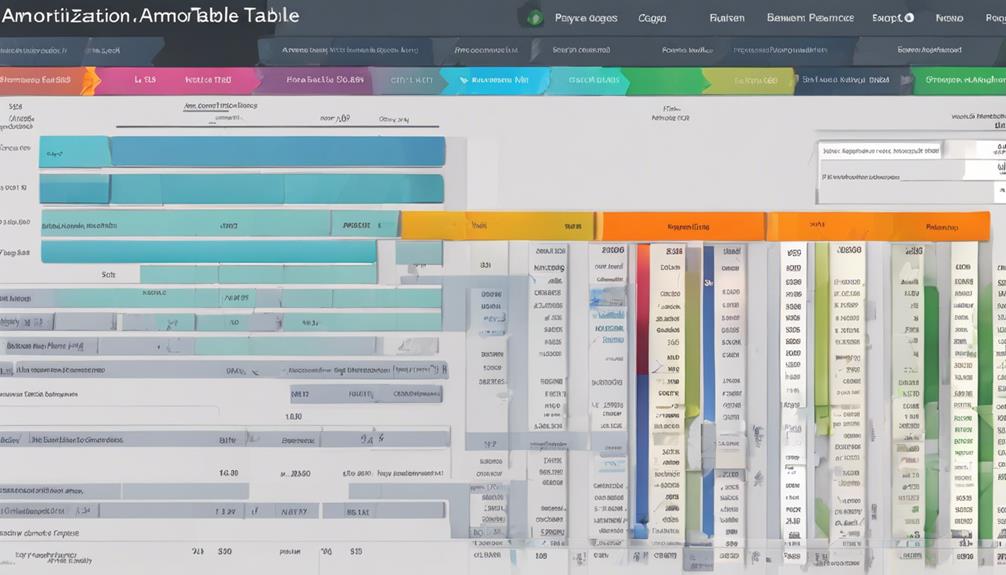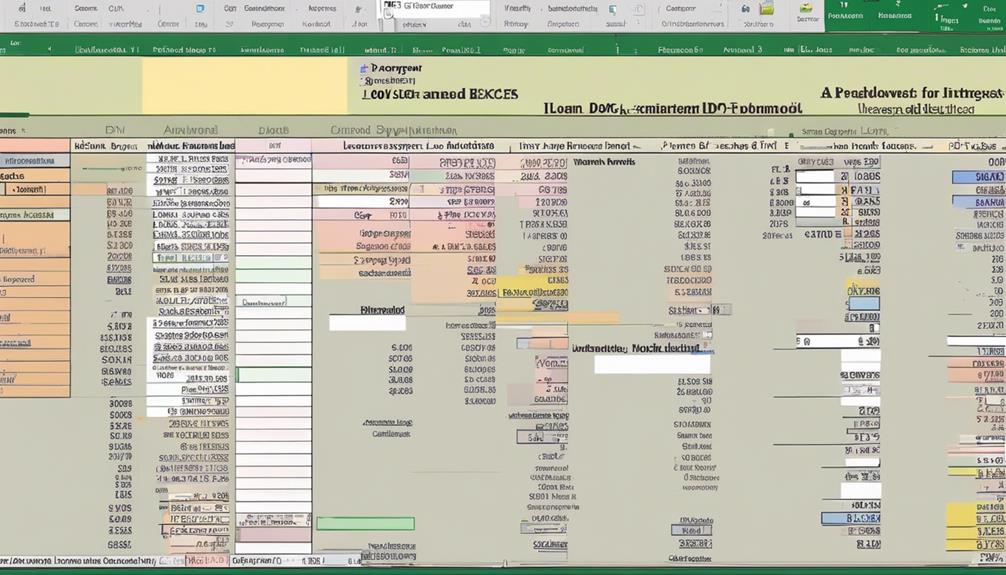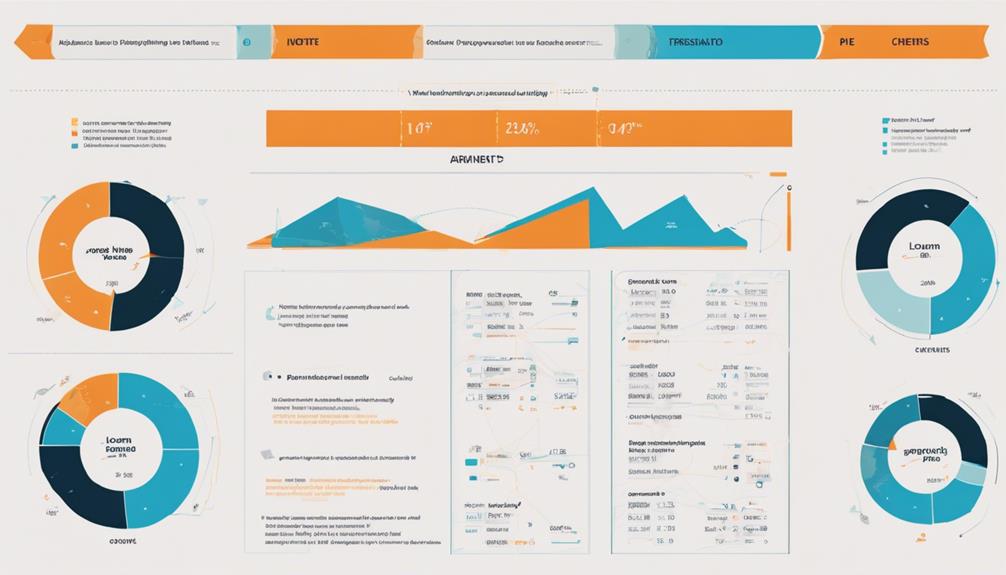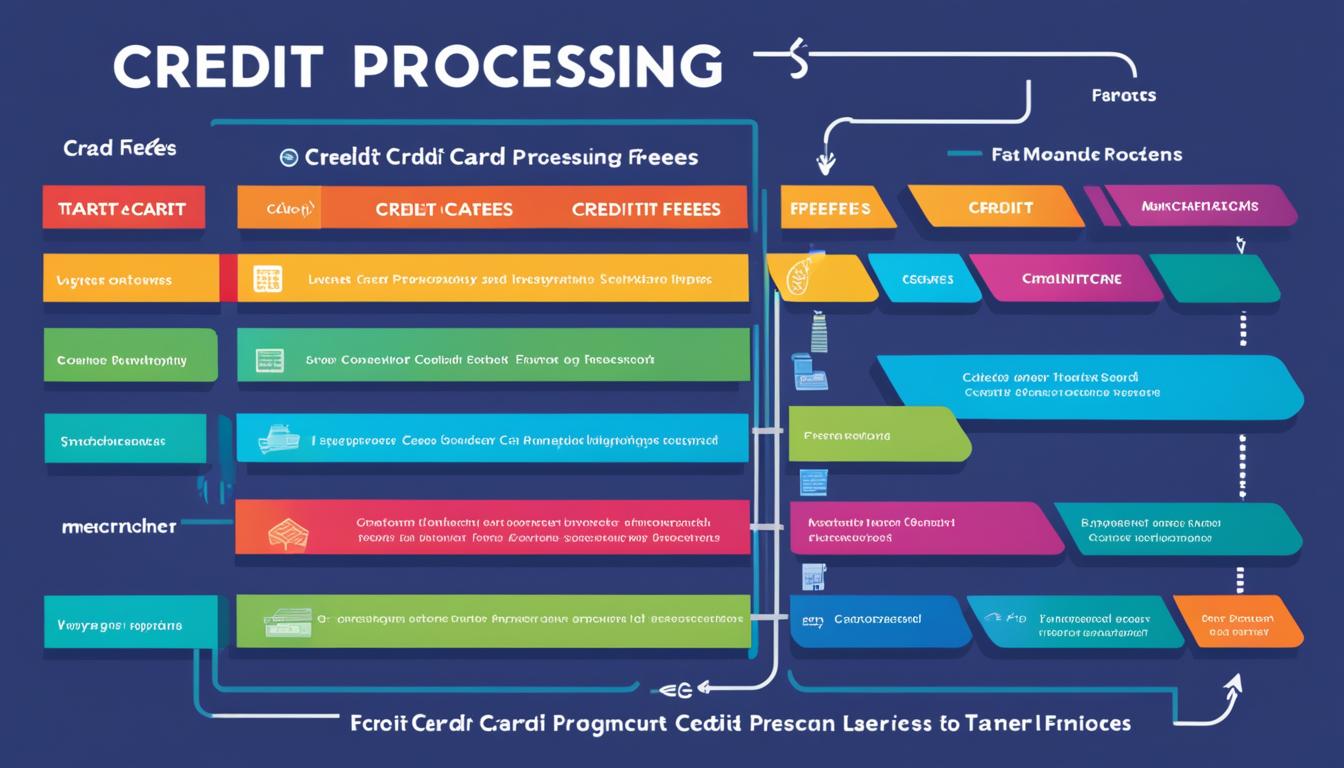Becoming proficient in loan payment processing requires comprehension of loan payment elements, loan types, interest rates, and fees. It is important to distinguish between interest-only and amortizing loans, accurately compute payments, and utilize loan calculators for precise estimations. By taking into account factors such as loan amount, repayment term, and APR, individuals can make informed financial choices to effectively manage their finances. More advanced strategies involve analyzing financial statements for loan approval, monitoring credit score impact, and leveraging automation software for streamlined processing.
Enhancing these skills ensures financial stability and well-being. Make sure to grasp these fundamentals for successful loan payment processing.
Key Takeaways
- Understand loan components and terms for accurate payment calculations.
- Differentiate between interest-only and amortizing loans for repayment strategies.
- Use loan calculators to estimate costs and make informed financial decisions.
- Consider factors like loan amount, APR, and terms for overall loan costs.
- Utilize tools like automation software for efficient loan processing and payment tracking.
Loan Payment Components Overview
Understanding the key components of loan payments is essential for tracking financial obligations and ensuring transparency in the repayment process. When it comes to loans, payment terms play a crucial role in determining the overall cost. The payment terms encompass the frequency and amount due for each installment.
Additionally, the interest rate applied to the loan significantly impacts the total amount repaid over time. It's vital to grasp how the interest rate influences the monthly payments and the overall cost of borrowing.
Types of Loans and Calculators

When it comes to understanding loan types and how to use calculators effectively, we're here to break it down for you.
Different loan structures such as interest-only and amortizing loans serve specific purposes, impacting how payments are made.
Utilizing tools like personal loan calculators can help estimate monthly payments accurately, providing valuable insights for financial planning.
Loan Types Overview
Exploring various loan types and calculators is essential for understanding how different financial options can meet individual needs. Interest-only loans involve paying only interest for a specified period, delaying principal repayment, while amortizing loans require monthly payments covering both principal and interest for gradual debt reduction. An auto loan calculator helps in planning car loan terms, considering factors like the loan amount, APR, and duration. To give you a clearer picture, here's a table summarizing the key points:
| Loan Type | Description | Calculator |
|---|---|---|
| Interest-Only Loan | Payment of only interest initially, delaying principal repayment. | N/A |
| Amortizing Loan | Monthly payments covering principal and interest for debt reduction. | Personal Loan Calculator |
| Auto Loan | Assists in planning car loan terms based on amount, APR, and duration. | Auto Loan Calculator |
Understanding these loan types and using appropriate calculators is crucial in making informed financial decisions.
Calculator Usage Tips
Using different types of loan calculators is essential for accurately estimating monthly payments based on key factors like principal amount, interest rate, and loan term. These calculators cater to specific loan types such as personal loans, student loans, mortgages, HELOCs, and auto loans. By inputting the necessary details, borrowers can visualize the impact of extra payments on their loan repayment and understand the total borrowing costs.
Whether dealing with interest-only loans or amortizing loans, these tools provide insights into repayment schedules and help in effective financial planning. Loan calculators empower individuals to take control of their finances by offering a clear breakdown of monthly payments and the overall cost of borrowing, aiding in informed decision-making and better management of various loan obligations.
Understanding Interest Rates and Fees
Interest rates and fees play a critical role in determining the overall cost of borrowing money through loans. Interest rates, expressed as a percentage of the loan amount, significantly impact the total amount repaid over the loan term.
Additionally, fees such as origination fees, closing costs, and prepayment penalties contribute to the overall cost of the loan. Understanding how interest rates and fees affect loan payments is crucial for making informed financial decisions.
Differentiating Interest-only and Amortizing Loans

When borrowing money, understanding the distinction between interest-only and amortizing loans is essential for effective financial planning and loan management.
Interest-only loans require borrowers to pay only the interest for a set period, delaying principal repayment. On the other hand, amortizing loans involve monthly payments that cover both the principal amount and the interest.
With interest-only loans, the principal balance remains unchanged during the interest-only period, potentially leading to higher total costs due to delayed repayment of the principal. In contrast, amortizing loans gradually reduce the outstanding balance with each payment, leading to a decrease in the total interest paid over time.
By recognizing the differences between these two types of loans, borrowers can make informed decisions that align with their financial goals and help them manage their loan balances effectively.
Understanding the dynamics of principal and interest in amortizing loans is crucial for maintaining control over one's financial obligations and achieving long-term financial stability.
Calculating Loan Payments Accurately

When calculating loan payments accurately, it's crucial to consider various factors such as the loan amount, interest rate, and repayment term. Utilizing tools like online calculators or formulas such as PMT in Excel can help ensure precise monthly payment calculations.
Additionally, factoring in any additional fees, like origination fees, provides a comprehensive view of the total loan costs.
Payment Calculation Methods
To accurately calculate loan payments, one must understand the crucial factors of the loan amount, interest rate, and repayment term. The financial implications of these elements play a significant role in determining the total payment amount.
By utilizing accurate payment calculation methods, individuals can gain better control over their financial obligations. Online loan payment calculators offer a convenient way to instantly compute payments based on specific inputs. These tools simplify the process and ensure precise results, aiding in financial planning.
Whether dealing with personal loans, mortgages, or auto loans, the calculation methods may vary, necessitating attention to detail. Accurate payment calculations empower borrowers to make informed decisions, effectively managing their finances and avoiding payment surprises.
Accuracy in Loan Payments
Accurate calculation of loan payments hinges on a thorough consideration of the principal amount, interest rate, and loan term. To ensure precision in your financial planning, follow these key steps:
- Understand the Loan Payment Formula: Familiarize yourself with the equation that governs loan payments to calculate them correctly.
- Utilize Online Calculators: Take advantage of online tools designed to assist in determining exact monthly payment amounts.
- Monitor Amortization: Recognize how monthly interest payments decrease over time as the principal balance diminishes, aiding in accurate payment calculations.
Analyzing APR and Repayment Terms

Analyzing APR and repayment terms offers a comprehensive understanding of the financial implications associated with borrowing.
The APR, which includes interest charges and fees, plays a critical role in determining the total cost of a loan. Alongside this, repayment terms, like the duration over which the loan must be repaid, directly influence monthly payments and the overall interest paid.
By examining how APR and repayment terms interact, individuals can effectively compare different loan offers to select the most cost-effective option. Longer repayment terms typically yield lower monthly payments but result in higher overall interest costs. Conversely, shorter terms may lead to higher payments but lower total costs in the long run.
Therefore, analyzing APR and repayment terms together provides a holistic view of the financial implications of borrowing, empowering individuals to make informed and advantageous decisions regarding their finances.
Factors Influencing Loan Costs

Understanding the key factors that influence loan costs is essential for making informed borrowing decisions. When considering a loan, several factors can impact the total cost you'll pay over time:
- Loan Amount: The amount you borrow directly affects the total cost of the loan. Typically, borrowing more money will result in higher overall costs due to increased interest payments.
- Repayment Term: The length of time you have to repay the loan plays a significant role in determining the total cost. Longer repayment terms often mean paying more in interest over the life of the loan.
- Annual Percentage Rate (APR): The APR includes not only the interest rate but also any additional lender fees. A higher APR translates to higher overall loan costs. Understanding how the APR impacts your payments is crucial for managing loan expenses effectively.
Making Informed Financial Decisions

Understanding the importance of making informed financial decisions is key when it comes to managing our money effectively. Factors like interest rates, repayment terms, and additional fees play a significant role in our decision-making process.
Fortunately, there are various tools available, such as loan calculators, that can assist us in evaluating our options and planning our finances wisely.
Financial Decision Importance
Making informed financial decisions is crucial for effectively managing loan payment processing. When it comes to financial decisions, especially regarding loan terms and interest rates, being well-informed can significantly impact your overall financial health. Here are three reasons why informed financial decisions are essential:
- Cost Savings: Making informed decisions can lead to significant cost savings in the long run by choosing favorable loan terms and lower interest rates.
- Better Loan Terms: Understanding the implications of different loan terms allows you to select the most suitable option that aligns with your financial goals.
- Improved Financial Stability: By making informed financial decisions, you can enhance your financial stability and avoid potential financial pitfalls.
Factors Impacting Decisions
Transitioning from the discussion on financial decision importance, we now focus on the factors that significantly influence making informed financial decisions, particularly in loan payment processing. When considering a loan, key factors such as the loan term, APR, and prepayment penalties play a crucial role in determining the total cost. The table below outlines how these factors impact decision-making:
| Factors | Impact on Decisions |
|---|---|
| Loan Term | Longer terms may lead to higher overall costs due to increased interest payments. |
| APR | The APR, including interest rates and fees, directly affects the total cost of the loan. |
| Prepayment Penalties | Penalties for early repayment can significantly impact the total cost, influencing strategic decisions. |
Decision-Making Tools Available
Bankrate provides interactive tools and calculators, assisting users in making informed financial decisions. When it comes to business, payments, and Loan Repayment, these decision-making tools available on Bankrate can be highly beneficial:
- Loan Payment Calculator: This tool helps users estimate their monthly loan payments based on the loan amount, interest rate, and term.
- Debt Payoff Calculator: Users can input their debt details to create a payoff plan, including the total amount paid and the time to become debt-free.
- Amortization Schedule Calculator: This tool provides a detailed breakdown of each loan payment, showing how much goes towards principal and interest over time.
Amortization Table Essentials

Exploring the essential elements of an amortization table enhances our understanding of loan payment breakdowns. An amortization table is a vital tool in the realm of loan payment processing, providing a detailed breakdown of each payment's components.
It outlines the payment date, total amount due, principal portion, interest portion, total interest paid to date, and the remaining loan balance. This breakdown empowers individuals by shedding light on how each payment contributes to the overall loan repayment process.
By utilizing an amortization table, one gains better control over their finances and can effectively plan for the future. This level of insight aids in tracking the progress of loan payoff, allowing for informed decisions and strategic financial management.
Understanding the intricacies of an amortization table is crucial for anyone seeking to navigate the complexities of loan repayment with confidence and clarity.
Setting Up Excel Spreadsheet

When setting up an Excel spreadsheet for loan payment processing, basic skills in data entry, formulas, and formatting are essential to create an organized layout. To ensure accuracy and efficiency, consider the following steps:
- Input Loan Details: Begin by entering key information such as the loan amount and interest rate into designated cells. This data serves as the foundation for your amortization table calculations.
- Utilize Formulas: Leverage Excel's formula functions to calculate payment amounts based on the loan terms provided. Utilizing formulas like PMT can help automate the process and reduce errors in your calculations.
- Organize Layout: Customize the spreadsheet layout to clearly display the amortization table. Use headings, borders, and color coding to distinguish between different components such as principal and interest payments.
Calculating Periodic Payments

After setting up the Excel spreadsheet for loan payment processing, the next step involves calculating periodic payments using financial functions like PMT to determine the fixed amount to be paid regularly. By inputting essential details such as the total loan amount, interest rate, and loan term, Excel can swiftly compute the periodic payment required. This calculation includes both principal amounts, which reduce the outstanding balance, and interest payments, which cover the cost of borrowing. Understanding how these payments are structured enables better financial planning and budgeting.
Accurate formulas for periodic payments are crucial as they ensure that the right amount is allocated towards reducing the loan balance. By utilizing Excel functions like PMT for total payments, IPMT for interest payments, and PPMT for principal payments, the process becomes more efficient and error-free. Visualizing payment allocation over time through Excel charts aids in tracking progress and making informed financial decisions based on the breakdown of principal and interest components.
Breaking Down Interest and Principal

Understanding the breakdown of interest and principal in loan payments is essential for effectively managing repayment strategies and optimizing financial planning. When analyzing loan payments, it's crucial to differentiate between the two components. Here's a breakdown to guide you through the process:
- Interest Payments: These represent the cost of borrowing money over time. Initially, a larger portion of your payment goes towards interest, gradually decreasing as the loan matures. Tracking these payments helps in understanding the total interest paid over the loan term.
- Principal Payments: Directly reducing the amount borrowed, principal payments contribute to lowering the outstanding balance. As you progress through the loan term, a higher proportion of your payment goes towards reducing the principal, accelerating the repayment process.
- Loan Repayment: By monitoring the split between interest and principal in each payment, you can develop strategies to pay off the loan more efficiently. This knowledge empowers you to make informed financial decisions and stay on track with your repayment schedule.
Advanced Tips for Loan Processing

To enhance efficiency and accuracy in loan processing, consider implementing advanced automation tools and specialized training for staff. Automation software can streamline processes, reducing manual errors and speeding up loan approvals. Real-time tracking systems allow for efficient monitoring of loan payments, ensuring timely processing. Training staff on specialized loan procedures is crucial for accuracy and compliance with regulations. Integrating accounting software that supports advanced loan processing functionalities can lead to seamless operations and improved customer service.
| Advanced Tips for Loan Processing | |||
|---|---|---|---|
| Real Estate | Financial Statements | Credit Score | |
| Explore real estate loan options and the impact on financial statements. | Analyze financial statements for loan eligibility and repayment capability. | Understand how credit scores affect loan approvals and interest rates. | |
| Automation Software | Real-Time Tracking | Specialized Training | Accounting Integration |
| Utilize automation tools to streamline loan processing and reduce errors. | Implement real-time tracking systems for efficient payment monitoring. | Train staff on specialized loan procedures for accuracy and compliance. | Integrate accounting software for seamless loan operations. |
Frequently Asked Questions
What Are the 4 Steps to Processing a Loan?
Here are the four steps to processing a loan: gather necessary documents, review borrower's financial info, analyze loan terms, and process the application. We verify creditworthiness, align terms with needs, and disburse funds accordingly.
What Is the Process of Loan Repayment?
We manage loan repayment by setting up schedules, making payments promptly, and tracking balances. Different methods like manual, automatic, or online transfers can be used. Missing payments can lead to penalties and harm credit scores.
How Do You Manage Loan Payments?
We set up automated systems for timely loan payment processing. We monitor schedules, send reminders to avoid delays, and use secure methods to protect information. Our software streamlines tracking and reconciliation, providing clear instructions for efficient processing.
What Is the Structure of a Loan Repayment?
Understanding the structure of a loan repayment is crucial. It includes the borrowed amount, interest rate, repayment term, and fees. Different loans have varying structures. We must grasp these details to manage our finances effectively.
What Similarities Do NPC Merchant Payment Processing and Loan Payment Processing Have?
Both NPC merchant payment processing and loan payment processing involve handling financial transactions. They both require a secure and efficient system to process payments, track transactions, and ensure proper documentation. Whether it’s processing credit card payments for goods or handling loan repayments, the importance of NPC merchant payment processing cannot be overlooked.
Conclusion
In mastering loan payment processing, we've laid the foundation for financial success. Just as each component of a loan payment plays a vital role, each step we take in understanding and calculating them brings us closer to our goals.
Like a well-oiled machine, our knowledge and skills in loan processing will keep our financial journey running smoothly. So let's continue on this path of learning and growth, armed with the tools to navigate the world of loans with confidence.









